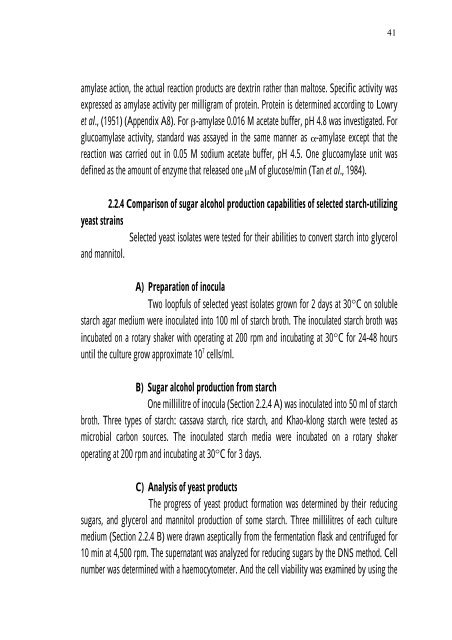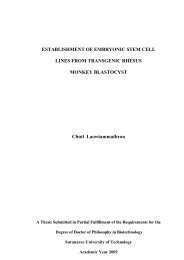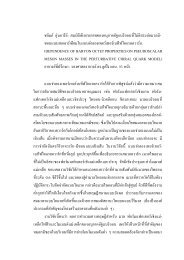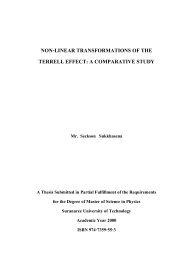PRODUCTION Of NUTRIENT SOURCES FOR RHIZOBIUM
PRODUCTION Of NUTRIENT SOURCES FOR RHIZOBIUM
PRODUCTION Of NUTRIENT SOURCES FOR RHIZOBIUM
Create successful ePaper yourself
Turn your PDF publications into a flip-book with our unique Google optimized e-Paper software.
amylase action, the actual reaction products are dextrin rather than maltose. Specific activity was<br />
expressed as amylase activity per milligram of protein. Protein is determined according to Lowry<br />
et al., (1951) (Appendix A8). For β-amylase 0.016 M acetate buffer, pH 4.8 was investigated. For<br />
glucoamylase activity, standard was assayed in the same manner as α-amylase except that the<br />
reaction was carried out in 0.05 M sodium acetate buffer, pH 4.5. One glucoamylase unit was<br />
defined as the amount of enzyme that released one µM of glucose/min (Tan et al., 1984).<br />
�<br />
�2.2.4 Comparison of sugar alcohol production capabilities of selected starch-utilizing<br />
yeast strains<br />
Selected yeast isolates were tested for their abilities to convert starch into glycerol<br />
and mannitol.<br />
A) Preparation of inocula<br />
Two loopfuls of selected yeast isolates grown for 2 days at 30°C on soluble<br />
starch agar medium were inoculated into 100 ml of starch broth. The inoculated starch broth was<br />
incubated on a rotary shaker with operating at 200 rpm and incubating at 30°C for 24-48 hours<br />
until the culture grow approximate 10 7 cells/ml.<br />
B) Sugar alcohol production from starch<br />
One millilitre of inocula (Section 2.2.4 A) was inoculated into 50 ml of starch<br />
broth. Three types of starch: cassava starch, rice starch, and Khao-klong starch were tested as<br />
microbial carbon sources. The inoculated starch media were incubated on a rotary shaker<br />
operating at 200 rpm and incubating at 30°C for 3 days.<br />
C) Analysis of yeast products<br />
The progress of yeast product formation was determined by their reducing<br />
sugars, and glycerol and mannitol production of some starch. Three millilitres of each culture<br />
medium (Section 2.2.4 B) were drawn aseptically from the fermentation flask and centrifuged for<br />
10 min at 4,500 rpm. The supernatant was analyzed for reducing sugars by the DNS method. Cell<br />
number was determined with a haemocytometer. And the cell viability was examined by using the<br />
��






